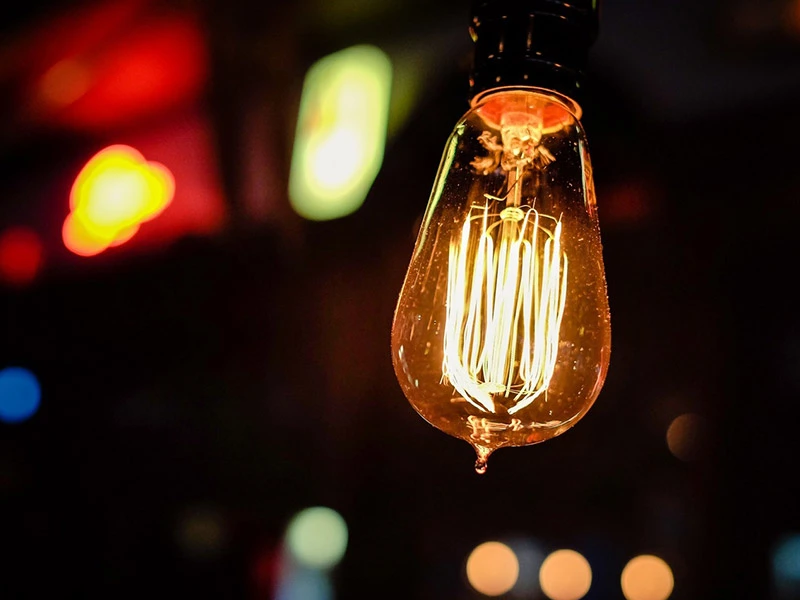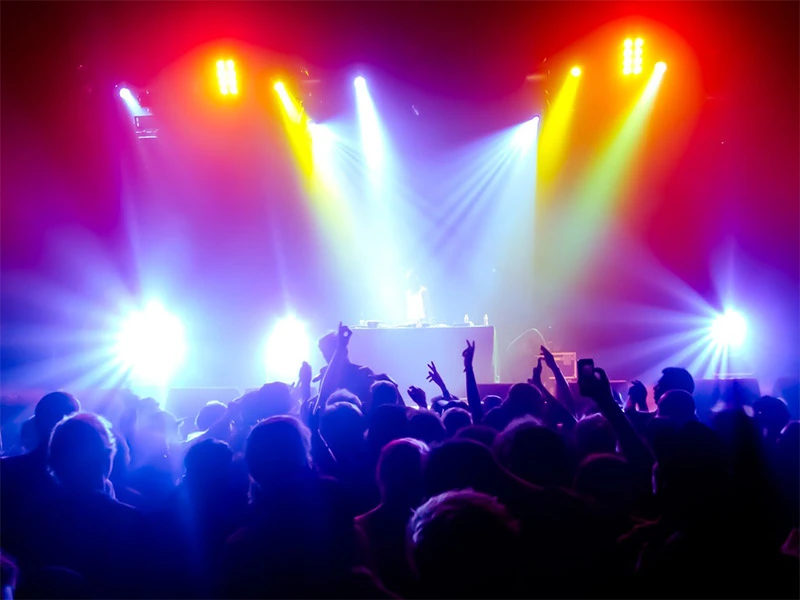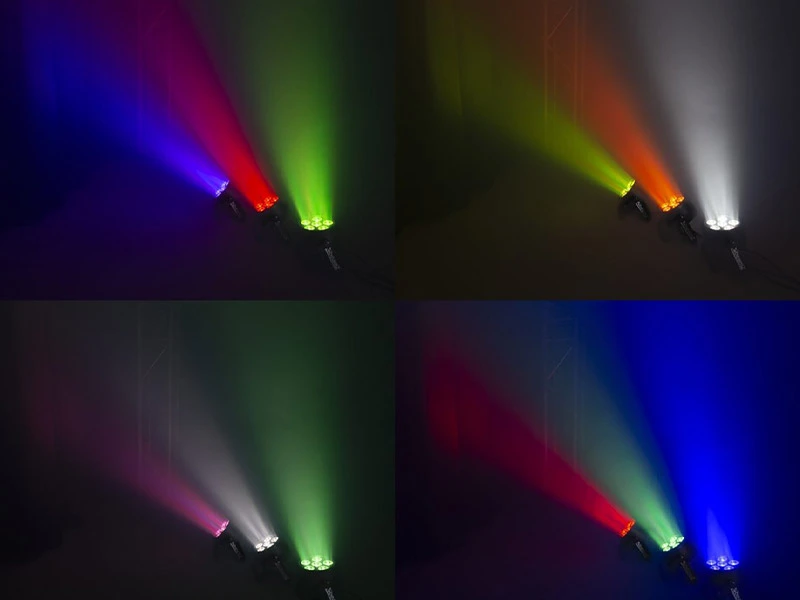LED Lamps vs Traditional Lamps
Light Source Types
When considering DJ and stage lighting, the choice between LED (Light Emitting Diode) and traditional bulbs (such as incandescent or halogen lamps) is significant, impacting everything from the quality of the light to the practicality of use in live performance settings.
Each type of lighting comes with its own set of advantages and disadvantages, and the "better" choice often depends on specific needs, such as brightness, colour accuracy, energy efficiency, and the atmosphere you aim to create.
What's the difference between LED and traditional lighting?
The main difference between an LED lamp and a traditional lamp or bulb is in how they produce their light output. DJ lighting specifically has relied on standard incandescent bulbs or reflector lamps for decades, with higher-power stage lighting using discharge lamps to get the required power and coverage for large venues.
LEDs have been around for decades, but their light output was always limited to millivolts and only red and green colours. Eventually, blue was created (which is the base for producing white) and more recent advancements in their chemical makeup and current handling allowed for their lumens capability to be increased significantly. LEDs soon become bright enough to replace standard light bulbs and fluorescent tubes.
An LED (light-emitting diode) is what’s known as a cold light source. It's a circuit-based device (semiconductor) that uses electrical current to release energy as visible radiation (light) through the production of photons. We already take them for granted, but they are an incredible scientific achievement. A traditional lightbulb (incandescent) is a hot light source. They work by passing current through a filament of wire, which heats up to a maximum capable amount (its wattage rating), and the light is the visible portion of this reaction.




Are LEDs better for DJ Lights than traditional bulbs?
LED technology offers a myriad of advantages over its conventional counterparts (such as incandescent or halogen bulbs), which has made them a preferred choice in almost all lighting fixtures and effects. It's one of those technologies that simply replaces what went before.
Firstly, energy efficiency is one of the most significant benefits of LED lights. LEDs consume a fraction of the energy required by traditional lights, translating to significantly lower electricity usage and a reduced environmental footprint. This efficiency does not come at the cost of luminosity; LED lights can be exceptionally bright and vibrant, offering a wide range of colours and effects that are perfect for creating dynamic atmospheres in DJ events.
Durability is another factor where LED lights outshine traditional options. LEDs are known for their long lifespan, often lasting tens of thousands of hours before needing replacement. This durability is partly because LED lights generate so much less heat than traditional bulbs, reducing wear and tear on the components and minimising the risk of overheating in a crowded venue.
Moreover, the versatility of LED lighting cannot be overstated. They can be programmed for an array of effects, from strobing and colour changing to dimming, without the need for external filters or mechanical parts. This has allowed DJ lighting to include far more features, while increasing performance, and at the same time lowering their overall cost.
What does RGBW mean in an LED?
RGBW stands for Red, Green, Blue, and White in the context of LED technology. This terminology is crucial in understanding how modern LEDs can produce a wide spectrum of colours, including a pure white light, enhancing the versatility and effectiveness of lighting solutions in various applications.
Traditionally, RGB LEDs combine red, green, and blue light to create a broad range of colours through the process of colour mixing. By adjusting the intensity of each primary colour, these LEDs can reproduce a wide palette of colours. However, one limitation of traditional RGB LEDs is their lack of ability to produce true white light. The white light generated by combining red, green, and blue often lacks the purity and brightness of natural white light, appearing more as a blend of colours rather than a true white.
With RGBW, the addition of a dedicated white chip allows for the production of pure, bright white light, significantly improving the quality and efficiency of white light output. This is particularly beneficial in applications where accurate colour rendering and a broad range of colour temperatures are crucial, such as in photography, interior lighting design, and stage effects lighting. Furthermore, the inclusion of a white LED chip enhances the efficiency of RGBW LEDs. When a pure white colour is needed, the white chip can be used on its own, consuming less energy than activating the red, green, and blue chips simultaneously to achieve a similar effect.
Specific to DJ and stage lighting, RGBW LEDs have been further enhanced to RGBAW-UV specification, which adds an amber light source and ultraviolet capability for a truly powerful lighting tool.


Read More...
The Future Is Here: LED Lighting Technology
The importance of LED lighting and especially LED effects lighting simply cannot be overstated. The technology has allowed for the implementation of new features, and for low-cost DJ lighting to become far more powerful and capable than ever before. Let's look a little further at the benefits, and some pros and cons for choosing LED over traditional bulb designs.
The Benefits of LED Stage Lighting
LED (Light Emitting Diode) stage lighting has revolutionised the performance and entertainment industry, offering huge benefits over traditional lighting technologies. The transition to LED lighting in stage settings has not only enhanced the visual experience for audiences but also introduced significant operational and environmental advantages.
LEDs boast a much longer lifespan compared to their traditional counterparts. While incandescent bulbs may need frequent replacements, LEDs can last for tens of thousands of hours, reducing maintenance costs and the inconvenience of frequent bulb changes during a production. This reliability ensures that shows can go on without a hitch, with minimal disruptions due to lighting failures.
The thermal difference is also enormous. Traditional halogen or tungsten stage lights generate a huge amount of heat, making the environment uncomfortable for performers and at the same time increasing the risk of heat-related damage to sensitive equipment. LED lights emit little to no heat, contributing massively to a more comfortable environment on stage, and reducing forced cooling costs for stages and auditoriums.
The removal of such excess heat production in effects lighting fixtures has also allowed for casings to switch from metal to tough plastics. This reduces the overall cost and halves the physical weight, which is hugely beneficial to lighting truss rig designers, and for ease of transportation.
Another key advantage of LED stage lighting is the versatility it offers. LEDs can produce a wide range of colours and intensities, all from the same lamp system. This ability eliminates the need for multiple fixtures or colour gels, enabling creative and dynamic lighting designs with ease. Moreover, LED lights can be dimmed to almost any level without changing the colour temperature, offering precise control over the lighting atmosphere.
LED stage lighting offers energy efficiency, longevity, versatility, and reduced heat emission, making it an environmentally friendly and cost-effective solution for modern stage productions. Its adoption not only enhances the visual appeal of performances but also aligns with broader sustainability goals, marking a significant advancement in the technology and art of stage lighting.
Operation
- LEDs generate light by passing an electrical current through a semiconductor material, which then emits light through the process of electroluminescence. This method is highly efficient and produces very little heat.
- Incandescent bulbs work by passing electricity through a filament, heating it until it glows. The process is inherently inefficient, as most of the energy is released as heat rather than light.
- Fluorescent lamps produce light by passing electricity through mercury vapour, which generates ultraviolet (UV) light. This UV light then excites a fluorescent coating inside the lamp to emit visible light.
Energy Efficiency
- LEDs are significantly more energy-efficient than traditional lighting, using up to 75% less energy than incandescent bulbs and about 30% less than fluorescent lights.
- Incandescent bulbs are the least efficient, with over 90% of the energy used lost as heat.
- Fluorescent lamps are more efficient than incandescent bulbs but less so than LEDs, with some energy lost as heat and UV light.
Lifespan
- LEDs have a much longer lifespan, often 25,000 to 50,000 hours or more, which reduces the need for frequent replacements.
- Incandescent bulbs typically last about 1,000 hours.
- Fluorescent lamps offer a lifespan of about 8,000 to 10,000 hours.
Environmental Impact
- LEDs have a lower environmental impact over their lifecycle, partly because of their energy efficiency and long lifespan. They also don’t contain mercury, unlike fluorescent lamps.
- Incandescent bulbs consume more energy, contributing to higher carbon emissions.
- Fluorescent lamps contain mercury, a toxic substance that requires careful disposal to avoid environmental contamination.
Cost
- LEDs generally have a higher upfront cost than traditional lighting options but offer savings over time through reduced energy consumption and replacement costs.
- Incandescent bulbs are cheaper upfront but more expensive in the long run due to higher energy bills and frequent replacements.
- Fluorescent lamps strike a middle ground in both upfront cost and operational efficiency.
Light Quality
- LEDs offer a wide range of colours and can be designed to mimic the warm glow of incandescent bulbs or the bright, white light of daylight. They also provide excellent colour rendering.
- Incandescent bulbs naturally produce a warm, yellowish light and have excellent colour rendering, making colours appear vibrant and true.
- Fluorescent lamps can sometimes cast a harsh, less natural light and may not render colours as accurately as incandescent bulbs or LEDs.
In summary, while LEDs have a higher initial cost, their advantages in energy efficiency, lifespan, environmental impact, and light quality make them a superior choice for most applications compared to traditional lighting technologies.
LED Lighting vs Traditional Lamps - The Pros and Cons
Lets take a look at some of the advantages and disadvantages of LED versus older style bulbs:
LED Advantages
- Energy Efficiency: LED lights consume significantly less energy than traditional bulbs, making them more cost-effective in the long run.
- Heat Emission: LEDs emit much less heat compared to traditional bulbs. This is a crucial advantage in a stage setting where the comfort of performers and the audience is a priority.
- Longevity: LED lights have a much longer lifespan, often lasting tens of thousands of hours before needing replacement.
- Colour Range: LEDs can produce a wide spectrum of colours without the need for external filters, enabling precise control over the visual ambience.
- Dimming Capability: LEDs offer superior dimming capabilities, allowing for smooth transitions without the flickering associated with dimming some traditional bulbs.
- Durability: They are more resistant to shock and vibration, making them suitable for moving and touring productions.
LED Disadvantages
- Initial Cost: At a professional level the upfront cost of LED lighting systems can be higher than traditional lighting options, though this is changing year by year as the technology becomes cheaper to produce. The initial cost is also offset by longer-term savings on energy and replacements.
- Quality Variation: There can be significant variation in colour quality and brightness among different LED products, especially in low-cost lighting, necessitating careful selection.
Traditional Bulb Advantages
- Upfront Cost: Traditional bulbs are generally cheaper to purchase initially than their LED counterparts.
- Colour Rendering: High-quality traditional bulbs can provide excellent colour rendering, producing warm light that is often preferred for its natural feel, especially in settings where the atmosphere is a priority.
- Simplicity: For smaller venues or simpler setups, traditional lighting might suffice, especially if budget constraints are tight and the technical demands are not as high.
Traditional Bulb Disadvantages
- Energy Consumption: Traditional bulbs are far less energy-efficient, consuming more power to produce the same level of brightness as LEDs, leading to higher running costs.
- Heat Emission: They emit a huge amount of heat, which can be a disadvantage in close quarters or small venues, affecting both performer comfort and climate control costs.
- Shorter Lifespan: Incandescent and halogen bulbs have a significantly shorter lifespan, requiring more frequent replacements.
- Durability: These bulbs are more fragile and susceptible to damage from movement, making them less ideal for touring or dynamic stage setups.
Traditional Bulb Disadvantages
The choice between LED and traditional lighting for DJ and stage applications ultimately depends on specific requirements and constraints. LEDs offer a more versatile, energy-efficient, and durable solution, suitable for a wide range of applications, including dynamic, colour-rich environments. Traditional bulbs, while being less efficient, might still be preferred in situations where the initial budget is limited or where the warmth and quality of incandescent lighting are desired for the ambience.
In the modern stage and DJ lighting context, LEDs are increasingly recognised as the superior option for most applications, offering a combination of efficiency, control, and creative potential that is hard to match with traditional lighting solutions. However, understanding the unique qualities of each lighting type allows for more informed decisions that best meet the needs of each specific performance or venue.


